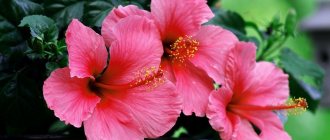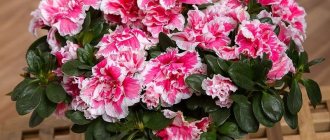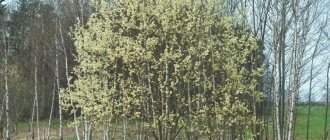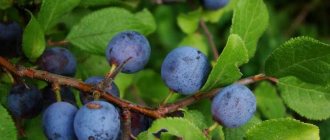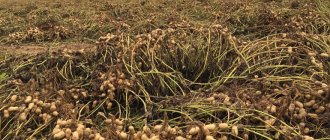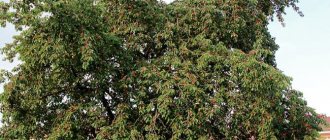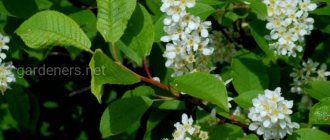Barberry is a heat-resistant shrub (sometimes a small tree) that does not require fertile soil. The deciduous plant loves light and does not tolerate waterlogging, especially stagnant water.
Barberry is an ornamental shrub, loved by gardeners for its versatility, unpretentiousness, beauty, and unusualness. The plant is planted separately and used as an addition to compositions; barberry is used to create hedges. Decorative properties make it possible to actively use barberry in landscape design.
The plant has been associated with humans since ancient times. Archaeologists have found mention of the property of barberry for purifying blood on clay tablets that were kept in the library of the Assyrian ruler Ashurbanipal. They date back to 650 BC.
The name of the plant comes from the Latin language (berberis), where in the Middle Ages it came from the Arabic language (بربرس - berbārīs). Translated, it means “Berber shell” due to the similarity of barberry fruits to the shell. The second name of the plant is caramel tree.
Nowadays the crop is distinguished by varietal diversity.
The most popular is the Thunberg barberry (Berberis thunbergii), a small plant from Japan that has spread throughout the world, giving rise to new varieties.
a brief description of
The name of the culture comes from “beiberi”, which means “shell-shaped” in Arabic. The plant covers approximately 170 species, some of which are grown by gardeners.
How does it grow?
Barberry is cultivated in the European part of Russia, in the Crimea, and in the Caucasus. The plant can also be grown in the forest-steppe zone.
Common barberry can be found on hillocks, in sparse forests, on rocky slopes, clearings and forest edges.
The shrub can also be cultivated as an ornamental plant.
How does it bloom?
The flowering period for barberry begins in April-May. The plant produces brushes consisting of 25 flowers, colored yellow. The shrub blooms for 21 days.
This crop is a good honey plant. Very sweet and aromatic honey can be obtained from the pollen of barberry flowers.
What does it look like?
Barberry is a highly branched bush with thorns that can reach almost three meters in height. The roots are cylindrical in shape and can be either curved or straight. The root system produces a lot of root shoots.
The branches are strewn with thorns, the length of which is 2 centimeters. In the first year, young branches have yellow bark, then it turns gray.
The leaves are located on short shoots in the axils of the spines. © https://ydoo.info/product/barbaris.html Taste sour. The shape of the leaves is thin, narrowed towards the petiole. The outer part is dark green and lighter underneath. With the arrival of autumn, the leaves turn a bright scarlet color.
The flowers are small in size, collected in a brush, and have a rich aroma. Each flower consists of six oblong light yellow petals.
The fruits are oblong cylindrical in shape, approximately 1 centimeter long. The berries are red in color and taste sour. The pulp of the fruit contains about 3 elongated seeds.
Are barberry berries edible?
Not all barberry berries are tasty and edible. Only common and Amur barberries can be eaten. Inedible varieties include Ottawa barberry and thunberga. Their taste has a strong bitterness. The berries also contain alkaloids (substances that cause bitterness), which have a negative effect on the human body.
Taste
Fresh barberry fruits taste sour, with notes of astringency. Moreover, depending on the variety, the taste may acquire sweetness or saltiness.
Smell
The berries of the plant smell quite pleasant. Their aroma is distinguished by a special spice that cannot be compared with anything else.
When to collect?
Harvesting generally occurs at the beginning or end of autumn. The collection time depends on the ripening time of a particular variety of shrub crop.
How to determine the ripeness of barberry berries? Fully ripened fruits should acquire a bright red color, and they should also be elastic and hard to the touch. If the berries are overripe, they become soft, wrinkle easily, and also acquire a dark red tint.
In what month do you pick barberry berries? In central Russia, the collection period falls in mid-August to early September. In the southern regions, the fruits ripen by early August. Also, the berries can hang on the bush until November, so the harvest is also harvested during this period.
What goes with it?
Amur barberry can get along with any garden crops. When planting, you need to select neighbors with a taproot system. Then the plants will be able to fully develop and not compete for nutrients and moisture.
This species combines well with conifers in group compositions. In this case, the plants complement each other well. Also, the ideal composition can be obtained by planting this species together with other varieties that will differ in leaf color.
Important! When placed close to other garden plants, the crop can suppress their growth.
How is it different from other berries?
Externally, common barberry is similar to other berries, such as goji, dogwood and thunberg barberry. However, there is still a difference between these plants. It manifests itself in the smell and characteristics of cultivation.
From Barberry thunberg
Common barberry, unlike thunberg, is not an ornamental crop. In addition, some species can reach 4 m in height, while the height of the thunberg does not exceed 2.5 m.
In thunberg, the color of the fruits can be varied (orange, coral, scarlet). The berries of barberry are always scarlet.
Thunberg, unlike the ordinary one, is resistant to infections (powdery mildew, rust) and dry climates, and is not picky about the type of soil.
From dogwood
Dogwood and barberry differ from each other in all respects.
- These plants belong to different families, so they have different chemical compositions of berries and other parts.
- Barberry fruits have several soft small seeds (about 3-5 pieces), and dogwood contains only one seed, hard to the touch, oblong in shape and large in size.
- Although both plants are used in folk medicine for the preparation of medicines, they are used to treat various diseases.
Even in color, dogwood differs from barberry. You will notice that the first one has a more saturated shade.
From goji berries
It is quite easy to distinguish barberries from goji berries. The fruits of the former are round, while the goji berries are oblong. Barberry berries are colored a rich dark burgundy, while goji berries have a predominantly carrot-red color. Plants also differ in taste. Barberry is sour, and goji berries are sweetish with a slight hint of sourness.
Goji is grown only in China, but barberry can be found everywhere. The leaves of the latter have an oval shape, while those of goji are oblong. The flowers of barberry are yellow, and those of goji are purple.
After drying, goji berries retain their color and original shape. Barberry becomes round and dark.
The difference between the two berries is also the price. Barberry is much cheaper than goji.
Berberis julianae (Juliana)
Juliana is a variety of barberry native to Central China. According to the description, it prefers a warm climate - in Russia it is grown in the south, in other regions the shoots freeze in winter. The height in unfavorable conditions does not exceed 50 cm. The bush has very long spines (up to 4 cm). The leaves are similar to bay leaves, they are hard and shiny. The flowers smell weak. They are collected in inflorescences of 15 pieces. Black oblong fruits ripen at the end of September.
Types and varieties
Today, barberry has a fairly large number of both species and varieties. The most famous varieties of the plant are:
- Amursky. The bush is 3.5 m in height, so this type of crop is not very popular among gardeners. The foliage is green in warm months and turns golden red in cold months. Blooms in late spring.
- Common barberry. Cultivated in Europe, Western Asia and the Caucasus. The shrub reaches 2.5 m in height. White or yellowish flowers bloom in May-June. Blooms for about 20 days. Used for food.
- Ottawa. Acts as a decorative appearance. The inflorescences are reddish-yellow and the leaves are lilac. During the colder months the foliage has a purplish hue. The bush blooms at the end of spring. The flowering period lasts two weeks.
- Thunberg. Decorative variety. Grows on the slopes of Japan and China. Grows up to 1.5 m. In warm months the foliage is red or yellow, and with the arrival of autumn the color changes to brown. The inflorescences are yellowish, with reddish edges. Flowering lasts 12 days. The berries are not eaten because they taste bitter.
Varieties of Amur barberry:
- “japonica” (3.5 meter bush, yellow flowers, golden leaves);
- “Orpheus” (height only 1 m, light green foliage, cannot bloom).
The following varieties belong to the common barberry:
- “aureomarginata” (one and a half meter bush, green foliage, framed at the edges with a golden border);
- “Juliana” (three-meter bush, green leaves become a rich scarlet color by autumn).
Ottawa barberry is represented by the following varieties:
- “auricoma” (two-meter bush, flowers and reddish foliage);
- “purpurea” (two-meter plant, purple foliage, yellowish-red flowers);
- “superba” (height 2.5-3 meters, in summer the leaves are reddish with a blue tint, and in autumn the color changes to orange or bright red, yellow-red flowers bloom in May, berries ripen by October).
Barberry thunberg is known for the following varieties:
- “atropurpurea” (two-meter bush, purple foliage, flowering occurs in June and lasts 12 days, berries form in October);
- “aurea” (80-centimeter bush, light orange leaves, yellow flowers with red ends, bloom in May for 14 days, fruits form in September);
- “bagatelle” (40-centimeter bush, the foliage is brown in summer and red in autumn, fruiting begins in October, the variety is planted in the garden as a hedge);
- “golden ring” (a three-meter shrub, the color of the leaves can be either yellow or red, yellowish flowers with a red edge bloom in May, and berries in October);
- “nana” (bush height 50 cm, yellow flowers and red leaves, flowering begins in May, berries ripen by October).
Of course, there are many more varieties and varieties of crops that are of interest. Each type of barberry has its own characteristics. The choice of shrub will depend on the goal pursued by the gardener.
Stages of hedge formation
In order for everything to turn out beautifully in the end, and not have to fix anything later, you need to immediately plant the shrub correctly from the very beginning. It is better to start work in early spring or mid-autumn.
The first step is to decide on the landing site. Variegated varieties do not grow well in partial shade. Lack of sun causes the foliage to remain green throughout the season. Its color constantly fades and eventually becomes unattractive. Therefore, for such plants you need to choose a well-lit area. If a hedge needs to be organized where there is little sun, it is worth planting shrubs with green foliage or the Thunberg variety. In open areas they quickly fade, but in partial shade they grow very well.
The Thunberg variety is planted in places poorly lit by the sun Source discus-club.ru
How to store at home?
It is necessary to store fresh barberries at home either in the refrigerator compartment or in a fairly dry and cool room. At room temperature, the fruits will begin to rot quickly.
However, the best option for storing the product is drying the berries. In this form, the shelf life of barberry can reach 2 years. In this case, the fruits should be placed in a fabric bag.
Decorative deciduous varieties
Ornamental deciduous barberry shrubs are, first of all, varieties:
- Thunberg Administration;
- Ottawa Superba;
- Silver Miles;
- Thunberg Harlequin;
- Atropurpurea Nana;
- Aurea;
- Bagatelli;
- Bonanza Gold;
- Golden Dream;
- Golden Ring;
- Green Carpet;
- Carmen;
- Coronita and many others.
It is these varieties that occupy a leading place in garden design. They look great both in groups and in single plantings against the background of a smooth lawn, emphasizing the splendor of multi-colored crowns. Moreover, they decorate the garden throughout the entire period - in late spring and early summer - with charming flowering, during the ripening period of berries - with a riot of green leaves, in autumn - with crimson foliage and bright fruits.
How to remove seeds?
There are two ways to remove seeds from barberry berries. In the first option, the fruit is cut in half, and then the seeds are removed using a knife or fingers. In this case, you need to do everything very carefully so as not to remove a large amount of pulp along with the seeds.
The second option involves boiling barberry. After this, the fruits are ground through a sieve. In this case, the bones will remain on the surface. This method is suitable for jams and preserves.
Which of these options is better cannot be said with certainty, since in both the first and second cases you will have to spend a lot of patience and time.
Reproduction
Amur barberry reproduces well by cuttings, layering and seeds. The best option for a novice gardener would be to buy a seedling, since propagation using seeds will take a lot of time.
To propagate a plant by cuttings, you need to carefully cut it, plant it in fertile soil, water it and wait until roots form. Then transfer it to a permanent place in open soil.
When propagating by layering, the shoot should be pinned to the ground and covered with damp soil. The soil needs to be moistened until the cuttings take root. Amur barberry can also be propagated by dividing the bush. This will not only provide planting material, but will also help rejuvenate the plant and maintain its intensive development. To do this, the bush must be carefully removed from the ground, divided and planted. In this case, the perennial thorny shrub Amur barberry will quickly take root and begin to bear fruit.
Use in cooking
Barberry fruits have found their place in cooking. The product is used for the production of syrups, jellies, juices, compotes, preserves and jams.
As a seasoning that adds sourness, dried and crushed barberries are added to meat dishes. To enhance the flavor, the product is placed in pilaf and kupaty (raw sausages).
Sour fruits are used in the production of liqueur and wine. Unripe berries are marinated and salted.
How to brew barberry?
Tea with barberry is very beneficial for the body. This drink has a calming, choleretic, antimicrobial and antipyretic effect.
There are several ways to brew barberry:
- Pour a couple of tablespoons of fresh berries with water (you will need 500 ml). The berries should be cooked in a water bath for 20 minutes. During cooking, some of the liquid will boil away. Therefore, after a specified period of time, the drink must be filtered, adding enough water so that the volume is again equal to 500 ml.
- Steam a teaspoon of barberry with boiling water (250 ml) and leave to brew for 10 minutes. The drink can be drunk without diluting with water. This tea has a rather sour taste, so you can add honey or granulated sugar to it.
- Pour a teaspoon of fresh berries into a glass of boiling water. The container containing the liquid should be wrapped. The drink is infused for 7 minutes. Then you need to add honey and lemon juice (a teaspoon each) to the tea.
- Pour a glass of boiling water over a teaspoon of dried fruits and add a teaspoon of sugar. Brew for 10 minutes. Filter the drink. You should drink the liquid warm after eating.
You can also brew black tea using barberry berries. To do this, you need to boil 600 ml of water. Wash and dry dried fruits. Add a tablespoon of black tea and 1.5 tablespoons of barberry to the teapot. Pour boiling water over the contents of the container and let it brew for 15 minutes. The finished tea is poured into mugs, where you can also add honey for sweetness.
How to make compote?
Barberry compote perfectly quenches thirst and also has a beneficial effect on the body, strengthening the immune system. Berry compote also lowers blood pressure and normalizes digestive activity.
To make barberry compote, you need:
- Carefully sort 200 grams of fresh berries (remove leaves and stems), then fill completely with water and wash. The liquid will have to be changed several times to better clean the product from dust and dirt.
- Place clean fruits in a deep saucepan, add 100 grams of granulated sugar and pour in 800 ml of water.
- As soon as the liquid boils, the fire must be kept low and the drink simmered until the berries give the liquid their taste, smell and color.
- If necessary, you can add a little more sugar. After this, the container with compote should be wrapped in a warm blanket and left to infuse for 30 minutes.
- After the specified time, the barberry compote can be poured into glasses and served.
This compote can be preserved for the winter. To do this, the finished hot drink is poured into sterilized jars and hermetically sealed.
How to infuse berries?
Alcohol tincture of barberry is used to treat many diseases (for example, hepatitis, cholecystitis and cholelithiasis). In addition, the drink improves appetite and normalizes the activity of the gastrointestinal tract.
You can infuse barberry berries with any alcohol-containing base. For these purposes, you can use vodka, alcohol or moonshine. Also, some cooks make barberry tincture with cognac.
On vodka
To infuse berries with vodka, you need:
- Wash 200 grams of barberry, dry it and put it in a container. Pour 500 ml of vodka over the fruits.
- Close the container and put it in a dark and well-heated place for 15 days. The liquid should be shaken thoroughly every three days.
- After the specified period of time, you need to put 3 clove buds, a cinnamon stick, a pinch of cumin and orange zest into the infusion.
- Next you need to repeat everything the same as in stage 2.
- Filter the composition and pour into a clean container.
- In a separate bowl, mix 100 ml of bottled water and 200 g of granulated sugar. Cook over low heat for 7 minutes, regularly skimming the foam from the surface of the syrup. The composition should cool to room temperature.
- Mix the syrup with the infusion, distribute into bottles and put in a cool place for four days.
The strength of barberry tincture is 26 revolutions. The drink can be stored for no more than 3 years. It is recommended to serve it with light snacks or desserts.
On moonshine
To make barberry tincture using moonshine, you need:
- Carefully sort through the fruits, leaving only the ripest and whole ones in the amount of 150 grams. Then the berries need to be washed and crushed.
- Place barberry in a glass container and pour in 2.5 liters of moonshine. Close the bottle and place in a dark place. Air temperature - +28 degrees.
- The liquid is infused for 15 days. The drink needs to be shaken daily.
- First, the liquid should be passed through a sieve, and then through a piece of cotton gauze.
- Add 150 grams of honey to the tincture and stir. After this, the drink must be poured into a clean bottle.
The barberry tincture should stand for three more days in a dark and cool room. After this you can taste it.
On alcohol
To make barberry tincture with alcohol, it is recommended:
- Place one kilogram of fruit in a bag and put it in the freezer for two days. After this, the berries need to be rinsed in warm water and placed in a jar. You also need to add 5 grams of vanilla sugar and a cinnamon stick.
- Dissolve 400 grams of linden honey in 400 ml of bottled water. Next, pour the mixture into the rest of the ingredients.
- Pour 800 ml of alcohol there. Close the container and put it in a dark and warm room for 60 days. The contents of the jar must be shaken daily.
- After the allotted period of time, the liquid should be removed from the sediment. The berries that remain at the bottom should be covered with sugar (100 grams) and put in a dark and warm place for 5 days. Drain the resulting berry syrup.
- After this, the berry syrup must be mixed with the alcohol infusion, which was previously removed from the sediment. The resulting liquid is filtered.
Pour the tincture into bottles and store in a cool place for 6 months.
What can I substitute in the recipe?
In the recipe, barberries can be replaced with cranberries. It, just like the product described, has a pronounced sour taste. This substitution will be appropriate in preparing pilaf.
In addition, some cooks use dogwood, raisins, prunes, cherry plum, tkemali, quince or sour plum instead of barberry. That is, to replace barberry berries, those products that have a sweet and sour taste are taken.
Instead of barberry, you can add sumac or pomegranate to meat products.
Harvesting barberry
So that you can enjoy barberry berries all year round, they can be prepared for the winter. To do this, the fruits are either frozen or dried. In both cases, the product will retain beneficial substances, as well as taste and aromatic qualities.
How to freeze?
To freeze barberries, fresh berries are sorted, washed and dried so that no excess moisture remains on the fruits.
Prepared berries are placed in bags or plastic containers and sent to the freezer for storage. The shelf life of frozen fruits is about 3 years.
One bag should contain as many berries as you can eat at one time. The product cannot be re-frozen, as it may lose its original appearance and taste.
How to dry it?
Drying barberry is, in principle, easy and relatively quick. In addition, the shelf life of the product reaches 2-3 years. At the same time, dried berries retain the same vitamins and minerals as fresh ones.
There are several ways to dry barberry. However, all options begin with one preparatory stage. The fruits are sorted, spoiled and rotten ones are removed. Then the good berries are thoroughly washed and dried.
In the oven
To dry the product in the oven, it is necessary to observe the temperature regime. The cooking process consists of the following steps:
- The prepared berries are laid out on a baking sheet covered with parchment paper and placed in an oven preheated to 50 degrees.
- As soon as the juice is released from the barberry, the temperature should be increased to 60 degrees.
- During the drying process, the berries must be stirred periodically.
- After 2.5 hours, the barberry will be ready.
Dried fruits should not release juice when squeezed.
In the microwave
To dry barberry in the microwave, you will need:
- Place fresh fruits between two paper napkins and place on a plate.
- The pieces are placed in the microwave for a couple of minutes. The power should be 200 W.
- After the specified time, the berries must be checked for readiness. If the product needs to be dried a little more, the oven should be turned on for 30 seconds, setting the same power as it was initially.
- It is best to dry barberry in several passes, each time checking the readiness of the product.
Well-dried fruits should remain soft, but no juice should leak from them.
In an electric dryer
Drying barberry berries in an electric dryer is somewhat reminiscent of drying the product in an oven. After the preparatory stage, the fruits are dried for 3 hours at a temperature of +50 degrees.
After this, the mode is increased to +60 degrees, and drying continues until the berries are completely ready.
The surface of the dried barberry should be glossy. When squeezed, no liquid should come out of the fruit.
Secrets of landscape designers
To quickly form a fluffy hedge, barberry is planted at a distance of 40 cm. The cuttings are slightly pruned, and the bush begins to fluff up due to the side shoots. If you scatter wood chips around each bush once, this will eliminate the need for constant weeding under the thorny bush.
Rules of care
The gardener's task is to grow a dense and dense bush, through which it is difficult to see the street. To make it look like this, you need to cut it often and mercilessly. All shoots that do not grow vertically must be pruned. It is worth immediately removing those branches that froze during the winter and dried out.
Proper cutting of barberry will allow you to get a beautiful landscape module Source allegroimg.com
Benefits for the body
Barberry contains many vitamins, minerals and other equally useful substances (ascorbic acid, carotene, tocopherol, organic acids, tannins), which have a positive effect on the human body.
Medicines are made from the plant that help with a number of diseases, namely:
- pain in the heart;
- high blood pressure;
- hemorrhoids;
- dysentery;
- diseases of the liver, kidneys, gall bladder, spleen, mouth, eyes;
- malaria;
- uterine bleeding;
- pleurisy;
- elevated body temperature;
- rheumatism;
- diabetes mellitus;
- tuberculosis;
- scurvy.
In addition, barberry has a laxative, antiseptic, tonic, antipyretic and diaphoretic effect. The plant is also able to eliminate severe wet coughs by removing phlegm from the bronchi.
At what age is it allowed to give barberry to children? Experts do not recommend including plant berries in children’s diets before the age of 12. Eating fruits can cause poisoning in children.
Women
Barberry will be useful for women both fresh and as part of decoctions and cosmetics. Berry face masks rid the skin of age spots and also remove dead cells.
Barberry-based decoctions improve general condition during menstruation, relieving lethargy. Also, folk remedies based on barberry increase the level of hemoglobin in the blood.
In addition, barberry is useful for weight loss. It is used to prepare compotes and juices that help burn fat and improve metabolism.
Barberry is contraindicated not only in the early stages of pregnancy, but also during the entire period of bearing a child. The product contains alkaloids that can cause contraction of most muscles. Eating even a small amount of barberry during pregnancy can cause miscarriage, swelling or bleeding.
Men
It is useful for men to eat barberry and drink decoctions based on it to speed up sperm motility (especially if there are problems conceiving a child), get rid of inflammatory diseases of the genitourinary system and prostatitis.
In folk medicine, to get rid of impotence, a special decoction based on rosehip and barberry is prepared, which increases blood flow to the pelvic organs, thereby increasing potency.
Berry drinks are also recommended to drink when playing sports. A barberry-based drink eliminates the feeling of fatigue and saturates the body with energy and strength.
Diseases and pests
Amur barberry is susceptible to various diseases that affect the quality of the crop and the life expectancy of the plant. It is important to detect and identify the disease in a timely manner and take appropriate measures. The most common disease is powdery mildew, which manifests itself as a powdery coating on leaves, shoots and fruits.
For better protection against diseases of the Amur Barberry bush, the necessary procedures should be followed. Firstly, remove dead foliage, trim dried shoots, and secondly, systematically carry out preventive treatment with a solution of colloidal sulfur, a sulfur-lime mixture. And remember to feed the root system with nutrients.
The perennial thorny shrub Amur barberry can also be attacked by pests, namely barberry aphids and flower moths. To ensure that the plant does not become a center of insect accumulation, protective operations must be carried out. In spring and autumn, remove and burn fallen leaves. Regularly inspect the Amur Barberry and, if pests are detected, urgently begin to combat them, resorting to mechanical and chemical methods of getting rid of various insects.
Medicinal properties
Due to its medicinal properties, barberry is widely used in folk medicine. Decoctions are prepared from the fruits, seeds, leaves, oil and even roots of the plant to relieve serious diseases. For example, with adenoids, barberry eliminates inflammation and also destroys pathogenic bacteria.
However, despite its healing properties, barberry also has a number of contraindications (described below), which should not be neglected so as not to harm the body. In particular, there is no need to abuse both the product and medicines based on this plant.
Yagod
To prepare decoctions, you must use only fully ripened barberries, otherwise you can cause severe poisoning. Often, the fruits of the plant are used to make medicines that help strengthen the immune system. To do this, fresh berries are mixed with honey and eaten.
To get rid of colds, a decoction is prepared. To do this, you need to pour a couple of tablespoons of berries with half a glass of water and simmer over low heat for 20 minutes. Then you need to add enough water to the drink to get the original volume. Take 50 milliliters three times a day.
Treatment of hemorrhoids with barberry berries also has a positive effect. It is enough to eat jam or several fresh fruits a day to relieve the symptoms of the disease.
Leaves
Barberry leaves help get rid of colds. Based on this part of the plant, decoctions are made that eliminate sore throats and also soothe paroxysmal coughs.
Leafy infusion of barberry is used as a choleretic and anti-inflammatory agent for diseases of the liver and gall bladder. For these purposes, a couple of tablespoons of dried leaves are steamed in a glass of boiling water for about half an hour. The infusion is filtered and taken 1 tbsp. l. four times a day. The course of treatment is 30 days.
Bark
Barberry bark is highly valued in folk medicine. Based on it, decoctions are prepared that help get rid of:
- diarrhea;
- gallstones;
- rheumatism;
- cramps in the stomach;
- cholecystitis.
Medicinal compositions based on the plant bark increase blood clotting. Therefore, decoctions are not recommended for people with heart and blood vessel problems.
For cholecystitis, hepatitis, inflammation of the gallbladder and kidneys, an infusion of the plant bark is used. To do this, 25 grams of bark are steamed with 400 ml of boiling water and left for 4 hours. The resulting infusion is filtered. Drink 100 ml 4 times a day for 30 days.
A decoction of barberry bark can cure conjunctivitis. To prepare the product, you will need a tablespoon of dried and crushed bark, pour 200 ml of hot water (the liquid should not boil). The composition simmers in a water bath for about 20 minutes. Then the product must be cooled and strained. Lotions are made from the decoction. The course of treatment lasts until complete recovery.
Roots
Barberry root has a choleretic effect, can normalize blood pressure, and also eliminate diarrhea.
In addition, the healing properties of the plant root are aimed at:
- normalization of kidney and liver function;
- cleansing the body of toxins;
- increased blood clotting;
- strengthening blood vessels.
For each type of disease, both decoctions and alcohol tinctures are used. The latter should be taken only after consultation with a doctor.
An infusion of barberry root is used for liver diseases (hepatitis). To prepare a healing infusion, add a couple of tablespoons of ground dry roots into a thermos and steam with 400 ml of boiling water. Leave for several hours and filter. Drink 100 ml three times a day for 30 days.
Barberry root also helps remove kidney stones. For these purposes, the following recipe is proposed: a mixture of ground barberry roots (50 g) and marshmallow (40 g), strawberry and birch leaves (20 g each), corn silk (20 g), pour a liter of water and boil for a quarter of an hour. Cool the composition to room temperature. Drink 150 ml three times a day. You can add a little honey to the broth.
In case of oncology, barberry root prevents the development of metastases. To make a medicinal decoction, you will need to take a teaspoon of dry root and bark of the plant, add 200 ml of hot water and boil in a water bath for a quarter of an hour. Cool the drink and filter. Use 2 tbsp. l. three times a day before meals.
Barberry oils
Oil obtained from barberry has found application in cosmetology for:
- rejuvenation and tightening of the skin, smoothing out wrinkles;
- relieving the inflammatory process in tissues;
- improving complexion, getting rid of freckles, acne and age spots.
In addition, barberry essential oil cares for hair, eliminating dandruff and oily curls, strengthening strands and saturating hair roots with essential nutrients.
To make your hair shine, you can add a little barberry oil to the rinse or shampoo.
The oil can also be added to cosmetic products for facial skin care. Due to this, the effect of the mask or cream will be much brighter.
Video description
The video reveals the secrets of barberry care:
Treatment with a fungicide solution can prevent the spread of the disease. In rainy summers, such treatment should be done once every two weeks. During hot dry periods, the frequency of spraying can be reduced to once a month. The last treatment is carried out after the leaves have completely fallen.
If you neglect to trim the bushes, they will quickly grow and become a solid thorny wall, the shape of which will then be extremely difficult to correct.
If the bush is left to grow naturally, it will quickly turn into a tall shaggy tree Source yandex.net
You need to take care of the plant by wearing thick gardening gloves on your hands, glasses on your eyes, and thick clothes on your body. This way you can protect yourself from sharp thorns.
Barberry for weight loss
The calorie content of barberry berries is not very high. On average, 100 grams of product contains only 36 kcal. Therefore, barberry is recommended for consumption during weight loss.
If you follow a dietary diet, you can not only eat fresh berries, but also prepare tea and infusions based on the product.
How to properly consume barberry fruits when losing weight:
- If the product serves as a snack, the main meal should be no later than an hour after eating the berries.
- Dried barberry can increase appetite. However, if you steam the fruits, this effect can be avoided.
- It is best to drink berry-based drinks, which will help fill the stomach, saturate the body and reduce the portion size.
To prepare barberry tincture you need:
- Place 20 grams of berries in a clean jar and add 200 ml of alcohol.
- Place the container in a dark and cool place for 15 days.
- When ready, shake the liquid thoroughly.
The tincture is taken one teaspoon 4 times a day after meals. The course lasts 20 days. Then you need to take a 2-week rest.
To prepare barberry tea, you need:
- Pour 100 grams of dried fruits into 200 ml of hot water.
- Cook the resulting mixture over low heat for 20 minutes.
- Pour the finished drink into a thermos and set aside to infuse for 4 hours.
- Before drinking, the tea is diluted with warm water in a ratio of 1:2, respectively.
You need to drink 70 ml of the drink 4 times a day 30 minutes before meals.
There is no need to make barberry-based tea for future use. It is enough to prepare a new portion of the drink at least once every two days. You can drink tea warm or cold. Granulated sugar is not added. The only thing you can add is a slice of lemon or a mint leaf.
Experts strongly recommend not to drink either tea or tincture if you are taking diuretics, as well as antibacterial or antihistamine medications.
Composition and calorie content of barberry
The low calorie content of the fruits of the caramel tree allows them to be included in various diets. There are only 30 calories per hundred grams of berries. The cooking process affects the change in calorie content of the fruit. So in one hundred grams of jelly there will already be more than 200 calories, in one hundred grams of compote - a little more than 100 calories. Dried barberry fruit contains 152 calories per 100 grams.
Fresh fruits contain about 10 grams of carbohydrates, 1 gram of proteins per 100 g of product. There are no fats in the fruits at all.
The chemical composition of Thunberg fruits is rich. The fruits contain:
- Vitamins: alpha-tocopherol (E), ascorbic acid (C), beta-carotene, group B.
- Natural acids: malic, citric, tartaric and others.
- Phenolic compounds, also called tannins.
- Pectin.
- Carotenoids.
- Macroelements: potassium, calcium, magnesium, sodium.
- Microelements: iron.
- Alkaloids - most of all berberine.
- Carotenoids.
- Resins.
- Tannins.
- Essential oil.
Harm and contraindications
Abuse of fresh berries, as well as long-term use of barberry-based tinctures and decoctions can cause colossal harm to the body.
In addition, the product is contraindicated for:
- allergies;
- varicose veins;
- high acidity of gastric juice;
- diseases of the kidneys, liver or gall bladder;
- heart diseases;
- uterine bleeding;
- thrombophlebitis.
Also, you should not eat unripe barberries. If the product is consumed in large quantities, cramps, dizziness and nausea may occur. The daily dose of the product is 150 grams.
It is not recommended to give berries to children under 12 years of age.
Barberry for diseases
Barberry and products based on it have different effects on the course of various diseases. Therefore, before consuming barberry compotes, infusions, decoctions, etc., it is advisable to consult with your doctor.
Hypothyroidism
With a long-term and persistent lack of thyroid hormones, experts allow the consumption of barberry berries, but only in small quantities, so as not to aggravate the condition.
Uterine bleeding
For uterine bleeding caused by menstruation or in the postpartum period, it is allowed to use barberry tincture. To prepare it, you need to pour 20 grams of leaves with 100 milliliters of vodka and leave for 15 days in a warm place. As soon as the drink turns dark yellow and acquires a sour taste, the tincture is ready. Take 30 drops three times a day. The course of treatment is 2 weeks.
However, this drug is contraindicated for use in case of gynecological bleeding or inflammation of the appendages.
Oncology
For oncology, traditional medicine experts advise using barberry infusion based on the roots and bark of the plant. This medicine acts as an additional treatment that will help stop the malignant process in the body.
High blood pressure
Barberry is able to lower high blood pressure due to the vasodilating effect inherent in these fruits. The berries also contain ascorbic acid, which helps strengthen the walls of blood vessels and prevent their fragility. In addition, barberry restores vascular tone, which has a positive effect on blood pressure.
For high blood pressure, take an infusion of barberry. To make it, you need to pour a tablespoon of plant flowers into 300 ml of water. The liquid is boiled for 10 minutes and then infused for 3 hours. The finished drink must be filtered.
Take a tablespoon before meals. The course of treatment lasts 30 days.
Cold
For colds, flu, and also to strengthen the immune system, take a decoction of barberry berries. For these purposes, the fruits are used to prepare fruit drinks, compotes, jam or preserves.
To treat colds faster and more effectively, you need to drink the decoction every day. If you drink the product only once, there will be no result.
Briefly about the main thing
Barberry is a shrub plant, the planting of which helps to create dense and very beautiful hedges.
To make them look decorative, you will have to frequently trim the plant both along the upper line of its growth and along the bottom. This procedure will give the landscape module the correct shape and prevent the appearance of “bald spots”.
There are a large number of varieties of barberry; for planting it is worth choosing those that tolerate cold winters well, “gain” the desired height and have beautifully colored foliage.
Ratings 0


